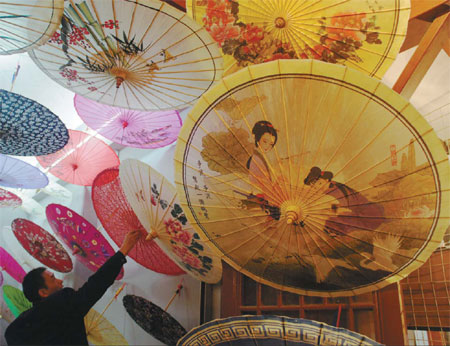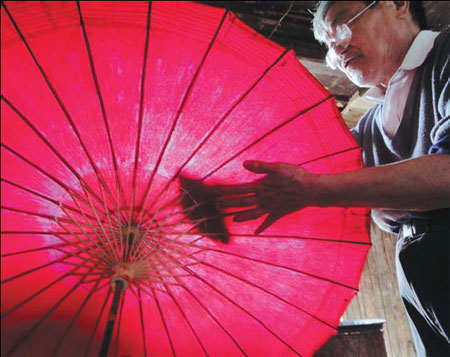Jiangnan style
Updated: 2013-05-17 08:42
By Zhang Lei (China Daily)
|
|||||||||||

|
Top: The wares of an oilpaper umbrella store in Xi'an. Above: A craftman makes an oilpaper umbrella in Anhui province. Photos Provided to China Daily |
Once a common sight, the oilpainted umbrella has all but disappeared across China, but a few artisans continue to keep the craft alive in the hope of a revival
Korean pop artist Psy's Gangnam Style swept the globe last year with his vivid mimicry of the rich living in Seoul's most prestigious neighborhood. Although Gangnam is Korean for "south of the river", it has connotations far beyond its literal translation. Most often among Koreans it conjures up an image of luxury, wealth and an ostentatious lifestyle.
The Chinese have their own "south of the river". Spelled Jiangnan in pinyin, the Chinese version is connected with images of a more poetic nature.
A vast blur of mist and rain during much of the year has taught people living along the south bank of the Yangtze River never to forget an umbrella. Thus, colorful oilpaper umbrellas were an essential piece of equipment many years ago.
"Holding up an oilpaper umbrella, I loiter aimlessly in the long, long and lonely rainy alley; I hope to encounter a lilac-like girl nursing her resentment." These are the words of a poem written by Dai Wangshu in the 1920s that have ever since struck a chord with Chinese longing for a certain romantic vision.
However, such cultural symbols, as quintessentially Chinese as they are, are now rarely seen anywhere in China, having been usurped by the modern umbrella. Now they can only be found in souvenir shops or museums.
"They are virtually dead in daily life, and for this reason alone, I hold those few who are still committed to this ancient art in high regard," says Wang Yunde, a researcher at the Chinese Ancient Art Society.
The traditional oilpaper umbrella is made with a wooden frame and hand-colored paper polished with candlenut tree oil.
As well as providing shelter from rain and sun, the 2,000-year-old art form is regarded by many people across Asia as a tool for warding off evil spirits.
As making them is time consuming and requires artistic skill, coupled with the fact there are few artisans of the craft left, oilpaper umbrellas are expensive compared with their factory-made counterparts, which sell for about 15 yuan ($2.40; 1.90 euros) in China.
According to China Information Industry Net, China exported nearly 4.67 billion umbrellas with sales revenue of more than $2.56 billion last year.
While China makes about 80 percent of the world's umbrellas, oilpaper umbrellas account for only a fraction of total production.
Although they almost disappeared from Chinese society 40 years ago, some artisans clung onto the craft in the hope of reviving it. Liu Youquan, an oilpaper umbrella maker in his 60s from Yuhang, Zhejiang province, bought 100 of them in 1970 as artisans were abandoning the craft because of the introduction of metal-framed umbrellas.
Liu too stopped making oilpaper umbrellas, until 2007, when he and three others returned to their old craft.
One bamboo shoot, five rolls of cotton thread, 18 pieces of Chinese painting paper and 36 wooden frame brackets are incorporated into an umbrella in a total of more than 70 procedures.
"In particular, the umbrella frames should be made from five-year-old bamboo that is specially treated to make it pliable, flexible and resistant to mold and pests," Liu says.
"The cover of the umbrella also requires special Chinese painting paper that can withstand strong force. Usually it takes at least 10 days to finish one umbrella".
Despite the amount of work that goes into making an umbrella, they have tried to keep the cost of buying one down, the minimum price being 150 yuan.
"Despite all these efforts, the most frustrating thing is that many people still think it is too old-fashioned and not easy to carry with you," Liu says.
In 2010, Liu hired a design team called Pinwu to help him modernize the umbrellas and arouse public interest.
In 2011, they took three of the new designs to Milan Design Week where people were both surprised and impressed, he says.
Zhang Lei, the designer who took the new designs to Milan, says his team spent two months living and working with the four craftsmen, using their techniques and learning from them.
"We created new designs by keeping the traditional roots. During this process we also found some details, materials and functions that we transferred into other products such as lamps, storage, trash bins and even chairs. We are searching for the future of the traditional paper umbrella."
Oilpaper umbrellas have not exactly enjoyed a revival yet, but appreciation of them is beginning to grow.
Cheng Dehu, manager of Beijing Ruo Shui Tang Oil Paper Umbrella Workshop, says, "Even if oilpaper umbrella making cannot return to its heyday, I think they will still be appreciated and collected as a kind of elaborate artwork."
zhanglei@chinadaily.com.cn
(China Daily 05/17/2013 page26)
Today's Top News
List of approved GM food clarified
ID checks for express deliveries in Guangdong
Govt to expand elderly care
University asks freshmen to sign suicide disclaimer
Tibet gears up for new climbing season
Media asked to promote Sino-Indian ties
Shots fired at Washington Navy Yard
Minimum growth rate set at 7%
Hot Topics
Lunar probe , China growth forecasts, Emission rules get tougher, China seen through 'colored lens', International board,
Editor's Picks

|

|

|

|

|

|






